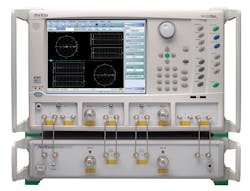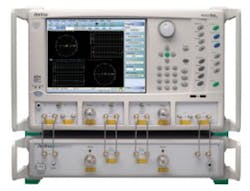Anritsu debuts differential noise-figure measurement for VectorStar VNAs
Philadelphia, PA. Anritsu at IMS introduced what the company calls the industry’s first solution capable of conducting extensive characterization of the differential noise figure of differential devices used in high-speed wireless communication systems. The solution, which integrates a new differential noise figure option into the Anritsu VectorStar vector network analyzers, allows R&D engineers to verify the receiver performance of low-noise amplifiers (LNAs) and other devices used in the front-end of 5G and microwave backhaul systems. The option is available on VectorStar models operating from 70 kHz and up to 20 GHz, 40 GHz, 70 GHz, and 110 GHz.
Measurement analysis of both correlated and uncorrelated noise can be conducted with the new differential noise-figure technique. The result is more comprehensive characterization of actual device performance for greater design confidence, the company said, adding that it is a superior method to conventional approaches that include an RF balun with only an S-parameter description or neglect correlation between device under test (DUT) output ports, which lead to improper characterization of differential devices. As operating frequencies continue to rise due to 5G, the ability to more accurately characterize device performance will take on added importance.
Accuracy is further ensured by the extended range of network tools for VectorStar. For example, the VNAs have the ability to embed or de-embed single-ended and differential probes and other networks during the on-wafer noise-figure measurement process and correct receiver calibrations for other setup changes. The result is more accurate noise-figure characterization of differential devices in an on-wafer environment.
The MS4640B VectorStar VNAs offer broad coverage in a single instrument, 70 kHz to 70 GHz. Coverage can be extended to 145 GHz and 1.1 THz in broadband configurations. Anritsu says VectorStar is the only VNA platform capable of measuring noise figure, both single-ended and differential, from 70 kHz to 125 GHz. The MS4640B VNA Series offers a new level of performance for device modeling engineers struggling to accurately and reliably characterize their devices, for R&D engineers pushing the last fraction of a dB out of their state-of-the-art designs, and for manufacturing engineers who must maximize throughput without sacrificing accuracy.

